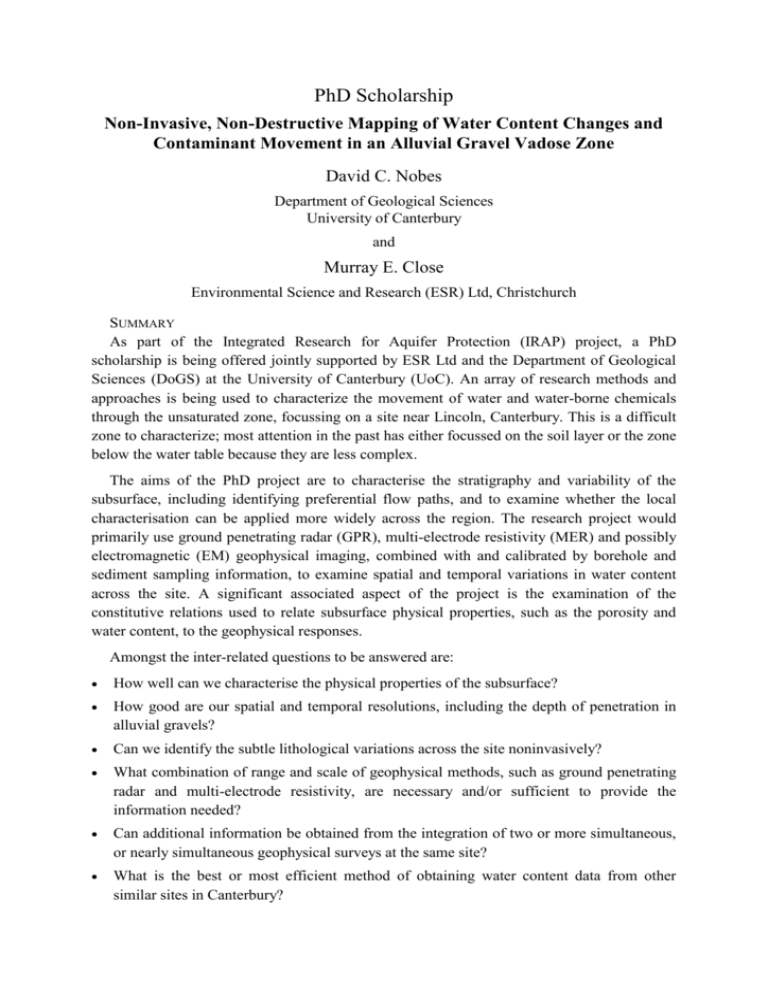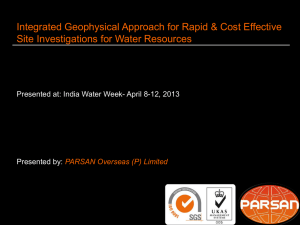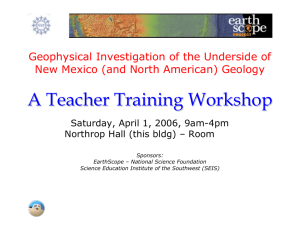Hastings EM31, GPR survey report
advertisement

PhD Scholarship Non-Invasive, Non-Destructive Mapping of Water Content Changes and Contaminant Movement in an Alluvial Gravel Vadose Zone David C. Nobes Department of Geological Sciences University of Canterbury and Murray E. Close Environmental Science and Research (ESR) Ltd, Christchurch SUMMARY As part of the Integrated Research for Aquifer Protection (IRAP) project, a PhD scholarship is being offered jointly supported by ESR Ltd and the Department of Geological Sciences (DoGS) at the University of Canterbury (UoC). An array of research methods and approaches is being used to characterize the movement of water and water-borne chemicals through the unsaturated zone, focussing on a site near Lincoln, Canterbury. This is a difficult zone to characterize; most attention in the past has either focussed on the soil layer or the zone below the water table because they are less complex. The aims of the PhD project are to characterise the stratigraphy and variability of the subsurface, including identifying preferential flow paths, and to examine whether the local characterisation can be applied more widely across the region. The research project would primarily use ground penetrating radar (GPR), multi-electrode resistivity (MER) and possibly electromagnetic (EM) geophysical imaging, combined with and calibrated by borehole and sediment sampling information, to examine spatial and temporal variations in water content across the site. A significant associated aspect of the project is the examination of the constitutive relations used to relate subsurface physical properties, such as the porosity and water content, to the geophysical responses. Amongst the inter-related questions to be answered are: How well can we characterise the physical properties of the subsurface? How good are our spatial and temporal resolutions, including the depth of penetration in alluvial gravels? Can we identify the subtle lithological variations across the site noninvasively? What combination of range and scale of geophysical methods, such as ground penetrating radar and multi-electrode resistivity, are necessary and/or sufficient to provide the information needed? Can additional information be obtained from the integration of two or more simultaneous, or nearly simultaneous geophysical surveys at the same site? What is the best or most efficient method of obtaining water content data from other similar sites in Canterbury? ESR/U of C Joint PhD Proposal Can we identify preferential flow paths, such as macropores, and how detailed must our surveys be to do so? Can we adapt statistical methods to extract additional information, particularly hydrogeological parameters, from the geophysical data? What are the lithological influences and controls on the extraction of hydrogeological information? The intense study of the one site, using complementary invasive and non-invasive methods, provides a rare opportunity to explore the questions associated with the movement of water and water-borne chemicals through the unsaturated zone, from the surface to the water table. RESEARCH GOALS Based on previous work, we can outline a number of clearly defined research goals: To accurately determine the stratigraphy and stratigraphic variation, a three-dimensional (3D) GPR and MER surveys should be completed. As much as possible, the work should be done within a short time frame so that changes in water content are negligible. The 3D survey should be repeated at least once to compare the results. To aid in this mapping, a range of GPR frequencies should be used: 50 MHz signals will yield the deeper and larger scale layering and structure; 100 MHz signals will yield more detail while still showing some of the layering and structure apparent in the 50 MHz results; and 200 MHz signals should be tested to see what detailed information can be obtained that is not available in the 100 and 50 MHz results. In particular, 200 MHz results would be better for comparisons with trench and logging data. A range of electrode separations should also be used, again to look at greater depth ranges, and to look at the changes in the electrical properties as a function of scale. To supplement the GPR and MER surveys, EM maps of electrical conductivity should be acquired. To obtain more detailed stratigraphic information, common mid-point (CMP) surveys should be done at a number of locations using a range of frequencies, as was done by Close et al. (2004). Specifically, 50, 100 and 200 MHz antennas should be used. A more dense spatial coverage should be used to obtain more accurate velocity information. To obtain stratigraphic information at depth, in addition to more dense spatial coverage, which will increase the signal stacking at later times, but more signal stacking at each location (trace) should be done to improve the signal-to-noise at depth. Models of GPR velocity and MER resistivity as a function of water content should be tested by using the water content as determined from shallow neutron logging and from direct soil measurements. We do not know the velocities when the soil is dry or saturated. Even after an extended period of drought, there can be residual water content, and after a prolonged period of rain, the soil may not be 100 % saturated, although it is likely to be. Using absolute velocity values can only yield qualitative results without additional information or constraints, and the calibrated water content is one such constraint. 2 ESR/U of C Joint PhD Proposal Finally, the geophysical results should be combined and, if possible, interpreted and modelled jointly, particularly GPR and resistivity. For example, the GPR stratigraphy can be used as a constraint in modelling the resistivity response, and the electrical properties can be used to constrain the radar signal attenuation. The electrical properties depend on the water content, water quality and clay content in a systematic way (modified Archie’s law, as in McNeill, 1990) that is different from the radar velocity. In principle, by combining the two sets of geophysical results, we can determine the porosity and saturation independently. In practice, the dependence is not simple, but depends on whether the water saturation is increasing (rain) or decreasing (Knight and Endres, 1990). A 3D electrical tomography survey would complement the GPR surveys, but both surveys would need neutron probe data in addition to trench and log data for calibration. Finally, the results should be extrapolated to other sites to test how well such surveys are representative of the broader region. RESEARCH TIMETABLE The proposed timeline for the research project is as follows: Year 1: Compile and collate previous work. Repeat GPR, resistivity and EM surveys in each season, but at a level of detail that is greater than the pilot surveys. Acquire direct measurements of the in situ soil properties as much as possible at the same time as the geophysical surveys are done. Process the geophysical results. Begin comparisons of calibrated results with models of physical properties as a function of, for example, water content. Year 2: Repeat GPR, resistivity and EM surveys in each season for a second year, to better delineate interannual and seasonal variability in the geophysical response. Repeat GPR, resistivity and EM surveys at new sites to test the extrapolation of the results from one site to another within a region. Repeat the soil property measurements. Write up previous year’s results for publication and presentation at national and international conferences. Continue comparisons of direct soil property measurements with models of the geophysical properties. Year 3: Complete processing of results and writing of thesis and papers for journal publication and conference presentation. 3 ESR/U of C Joint PhD Proposal REFERENCES Close, M. E., Nobes, D. C. and Pang, L., 2004. Presence of preferential flow paths in shallow groundwater systems as indicated by tracer experiments and geophysical surveys. In Hyndman, David & Bridge, John (eds), Aquifer Characterization, SEPM Special Publication, 80: 79-91. Knight, R. and Endres, A, 1990. A new concept in modelling the dielectric response of sandstones: Defining a wetted rock and bulk water system. Geophysics, 55: 586-594. McNeill, J. D., 1990. Electromagnetic methods. In S. N. Ward (ed), Geotechnical and Environmental Geophysics, Vol. I: Review and Tutorial, Society of Exploration Geophysicists, Tulsa, Oklahoma, 191 - 218. 4



